Manufacturing and Properties of Various Ceramic-Embedded Composite Fabrics for Protective Clothing in Gas and Oil Industries Part II: Thermal Wear Comfort via Thermal Manikin
Abstract
:1. Introduction
2. Methodology
2.1. Master Batch (M/B) for Conjugated Yarns Specimens
2.2. Spinning of the Bi-Component Yarn Specimens
2.3. Fabrication of Composite Fabric Specimens
2.4. FIR Emissivity Measurement and Ingredient Analysis of Yarn Specimens
2.5. Measurement of Thermal Property of the Composite Fabrics
2.6. Thermal Insulation Rate (Clo) Measurement by a Thermal Manikin Apparatus
3. Results and Discussion
3.1. FIR Emissivity (γ) of the Yarn Specimens
3.2. Ingredient Analysis with SEM Images of Yarn and Fabric Specimens
3.3. Thermal Insulation Characteristics (Clo Value) of Clothing
3.4. Thermal Insulation Characteristics (Sub-Clo Values) at Stomach and Chest Positions
3.5. Comparison between Clo Value of Clothing and Heat Retention Rate (I) of Fabric
4. Conclusions
Funding
Institutional Review Board Statement
Informed Consent Statement
Data Availability Statement
Conflicts of Interest
References
- Pooley, M.A.; Anderson, D.M.; Beckham, H.W.; Brennan, J.F., III. Engineered emissivity of textile fabrics by the inclusion of ceramic particles. Opt. Express 2016, 24, 10556–10564. [Google Scholar] [CrossRef]
- Stygiené, L.; Varnaite-Žuravliova, S.; Abraitiené, A. Investigation of thermoregulation properties of various ceramic-containing knitted fabric structures. J. Ind. Text. 2020, 50, 716–739. [Google Scholar] [CrossRef]
- Kuo, C.F.J.; Fan, C.C.; Su, T.L.; Chen, S.H.; Lan, W.L. Nano composites fiber process optimization for polypropylene with antibacterial and far-infrared ray emission properties. Text. Res. J. 2016, 86, 1677–1687. [Google Scholar] [CrossRef]
- Negishi, N.; Kikuchi, M. Infrared ray effects in biological systems. Ceram. Jpn. 1988, 23, 335–339. [Google Scholar]
- Xu, W.; Shyr, T.; Yao, M. Textile’s properties in the infrared irradiation. Text. Res. J. 2007, 77, 513–519. [Google Scholar] [CrossRef]
- Furuta, T.; Shimizu, Y.; Kondo, Y. Evaluating the temperature and humidity characteristics of solar energy absorbing and retaining fabric. Text. Res. J. 1996, 66, 123–130. [Google Scholar] [CrossRef]
- Bahng, G.W.; Lee, J.D. Development of heat-generating polyester fiber harnessing catalytic ceramic powder combined with heat-generating super microorganisms. Text. Res. J. 2014, 84, 1220–1230. [Google Scholar] [CrossRef]
- Hoque, M.d.S.; Dolez, P.I. Aging of high-performance fibers used in firefighter’s protective clothing: State of the knowledge and path forward. J. Appl. Pol. Sci. 2023, 140, e54255. [Google Scholar] [CrossRef]
- He, H.; Qin, Y.; Liu, J.; Wang, J.; Zhao, Y.; Zhu, Z.; Jiang, Q.; Wan, Y.; Qu, X.; Yu, Z. A wearable self-powered fire warning e-textile enabled by aramid nanofibers/MXene/silver nanowires aerogel fiber for fire protection used in firefighting clothing. Chem. Eng. J. 2023, 460, 141661. [Google Scholar] [CrossRef]
- Makinen, H. Firefighter’s protective clothing. In Textiles for Protection; Scott, R.A., Ed.; The Textile Institute: Manchester, UK; Woodhead Publishing Limited: Cambridge, UK; CRC Press: Boca Raton, FL, USA, 2005; pp. 622–647. [Google Scholar]
- Holmes, D.A. Waterproof breathable fabrics. In Handbook of Technical Textiles; Horrocks, A.R., Anand, S.C., Eds.; The Textile Institute: Manchester, UK; Woodhead Publishing: Cambridge, UK; CRC Press: Boca Raton, FL, USA, 2005; pp. 282–314. [Google Scholar]
- Kim, H.A.; Kim, S.J. Wear comfort properties of ZrC/Al2O3/graphite embedded heat storage woven fabrics for garments. Text. Res. J. 2019, 89, 1394–1407. [Google Scholar] [CrossRef]
- Kim, H.A. Wear comfort and thermal insulation of ceramic-imbedded fabrics with different yarn structures by thermal manikin experiment. Int. J. Cloth. Sci. Technol. 2022, 35, 197–213. [Google Scholar] [CrossRef]
- Rabiei, H.; Dehghan, S.F.; Montazer, M.; Khaloo, S.S.; Koozekonan, A.G. UV protection properties of workwear fabrics coated with TiO2 nanoparticles. Front. Public Health 2022, 10, 929095. [Google Scholar] [CrossRef] [PubMed]
- Attia, N.F.; Moussa, M.; Sheta, A.M.; Taha, R.; Gamal, H. Effect of different nanoparticles based coating on the performance of textile properties. Prog. Org. Coat. 2017, 104, 72–80. [Google Scholar] [CrossRef]
- Xin, J.J.; Daoud, W.A.; Kong, Y.Y. A New Approach to UV-Blocking Treatment for Cotton Fabrics. Text. Res. J. 2004, 74, 97–100. [Google Scholar] [CrossRef]
- Yang, H.Y.; Zhu, S.K.; Pan, N. Studying the Mechanisms of Titanium Dioxide as Ultraviolet-Blocking Additive for Films and Fabrics by and Improved Scheme. J. Appl. Polym. Sci. 2003, 92, 3201–3210. [Google Scholar] [CrossRef]
- Saito, M. Antibacterial, Deodorizing, and UV Absorbing Materials Obtained with Zinc Oxide (ZnO) Coated Fabrics. J. Coat. Fabr. 1993, 23, 150–164. [Google Scholar] [CrossRef]
- Xiong, M.N.; Gu, G.X.; You, B.; Wu, L.M. Preparation and Characterization of Poly (styrenebutylacrylate) Latex/Nano-ZnO Nanocomposites. J. Appl. Polym. Sci. 2003, 90, 1923–1931. [Google Scholar] [CrossRef]
- Wang, R.H.; Xin, J.J.; Tao, X.M.; Daoud, W.A. ZnO nanorods grown on cotton fabrics at low temperature. Chem. Phys. Lett. 2004, 398, 250–255. [Google Scholar] [CrossRef]
- Dang, H.B.; Luc, O.H.; Le, T.; Le, V.H. The optimum fabrication condition of p-type antimony tin oxide thin films prepared by DC magnetron sputtering. J. Nano Mater. 2016, 687, 1012–1022. [Google Scholar] [CrossRef]
- Wu, Y.; Chi, Y.B.; Nie, J.X.; Yu, A.P.; Chen, X.H.; Gu, H.C. Preparation and application of novel fabric finishing agent containing nano ATO. J. Funct. Polym. 2002, 15, 43–47. [Google Scholar]
- Wong, Y.W.H.; Yuen, C.W.M.; Leung, M.Y.S.; Ku, S.K.A.; Lam, H.L.I. Selected applications of nanotechnology in textile. AUTEX Res. J. 2006, 6, 1–8. [Google Scholar]
- Li, Y.; Wu, D.X.; Hu, J.Y.; Wang, S.X. Novel infrared radiation properties of cotton fabric coated with nano Zn/ZnO particles. Coll. Surf. A 2007, 300, 140–144. [Google Scholar] [CrossRef]
- Ahn, T.X.; Tung, D.T.; Nhan, D.Q.; Hoang, T.V.; Trung, D.Q.; Thu, L.D.; Hoang, P.H.; Cuong, N.D. Study of ATO nanoparticles by the solvothermal method for thermal insulated coated glass: A green energy application. Green Process. Synth. 2016, 5, 529–535. [Google Scholar]
- Sun, H.; Liu, X.; Liu, B.; Yin, Z. Preparation and properties of antimony doped tin oxide nanopowders and their conductivity. Mater. Res. Bull. 2016, 83, 354–359. [Google Scholar] [CrossRef]
- Zhou, Z.W.; Chu, L.S.; Tang, W.M.; Gu, L. Studies on the antistatic mechanism of tetrapod-shaped zinc oxide whisker. J. Electrost. 2003, 57, 347–354. [Google Scholar] [CrossRef]
- Crown, E.M.; Dale, J.D. Protection for workers in the oil and gas industries. In Textiles for Protection; Scott, R.A., Ed.; The Textile Institute: Manchester, UK; Woodhead Publishing Limited: Cambridge, UK; CRC Press: Boca Raton, FL, USA, 2005; pp. 699–713. [Google Scholar]
- Sarkar, A.K. Textiles for UV protection. In Textiles for Protection; Scott, R.A., Ed.; The Textile Institute: Manchester, UK; Woodhead Publishing Limited: Cambridge, UK; CRC Press: Boca Raton, FL, USA, 2005; pp. 355–377. [Google Scholar]
- Kim, H.A. Manufacturing and properties of various ceramic embedded composite fabrics for protective clothing in gas and oil industries Part I: Anti-static and UV protection with thermal radiation. Coatings 2023, 13, 1481. [Google Scholar] [CrossRef]
- Kim, H.A. Wear Comfort Characteristics of Al2O3/ATO/TiO2-Embedded Multi-Functional PET Fabrics. Materials 2022, 15, 8799. [Google Scholar] [CrossRef]
- KS K 15831; Clothing-Physiological Effect Measurement of Thermal Insulation by Means of a Thermal Manikin. Korea Industry Standard Commission: Seoul, Republic of Korea, 2004.
- Kim, H.A. Ultra-violet protection and anti-static characteristics with heat release/shielding of Al2O3/ATO/TiO2-imbedded multi-functional fabrics. Materials 2022, 15, 3652. [Google Scholar] [CrossRef]
- Lin, J.H.; Huang, C.L.; Lin, Z.I.; Lou, C.W. Far-infrared emissive polypropylene: Wood flour wood plastic composites: Manufacturing technique and property evaluations. J. Compos. Mater. 2016, 50, 2099–2109. [Google Scholar] [CrossRef]
- Lin, J.H.; Jhang, J.C.; Lin, T.A.; Huang, S.Y.; Chen, Y.S.; Lou, C.W. Manufacturing techniques, mechanical properties far infrared emissivity and electromagnetic shielding effectiveness of stainless steel/polyester/bamboo charcoal knits. Fiber Polym. 2017, 18, 597–604. [Google Scholar] [CrossRef]
- Lin, C.A.; An, T.C.; Hsu, Y.H. Study on the far infrared ray emission property and absorption performance of bamboo charcoal/polyvinyl alcohol fiber. Polym. Plast. Tech. Eng. 2007, 46, 1073–1078. [Google Scholar] [CrossRef]
- Kim, H.A. Investigation of moisture vapor permeability and thermal comfort properties of ceramic embedded fabrics for protective clothing. J. Ind. Text. 2022, 52, 1–27. [Google Scholar] [CrossRef]
- Ralaskar, S.; Desai, A.; Shukla, S. Development of multifunctional cotton fabric using atmospheric pressure plasma and nano-finishing. J. Ind. Text. 2016, 107, 405–412. [Google Scholar] [CrossRef]
- Das, B.R. UV radiation protective clothing. Open Text. J. 2010, 3, 14–21. [Google Scholar]
- Kar, T.R.; Samanta, A.K.; Sajid, M.; Kaware, R. UV protection and antimicrobial finish on cotton khadi fabric using a mixture of nanoparticles of zinc oxide and poly-hydroxy-amono methly silicone. Text. Res. J. 2019, 89, 2260–2278. [Google Scholar] [CrossRef]

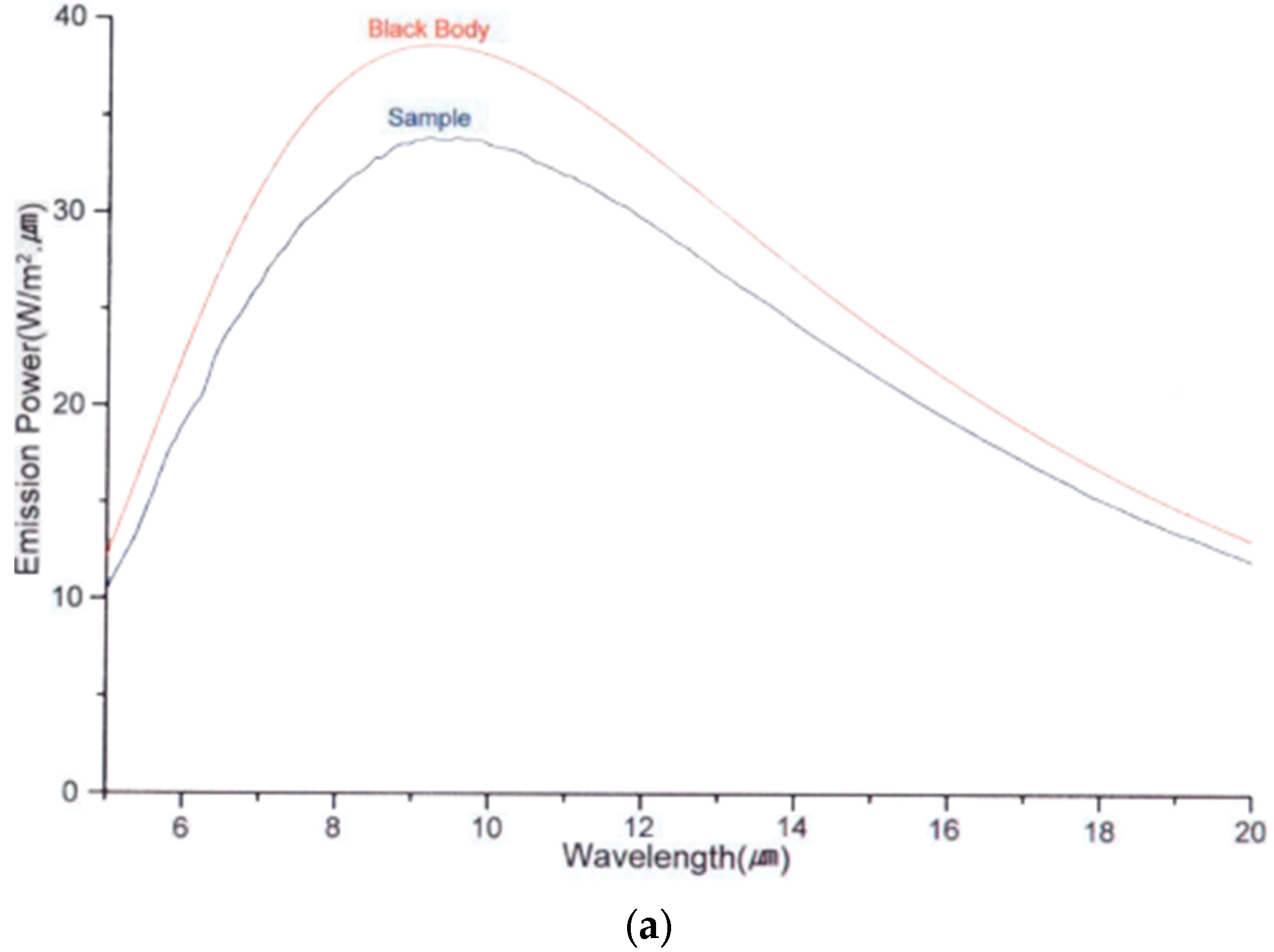
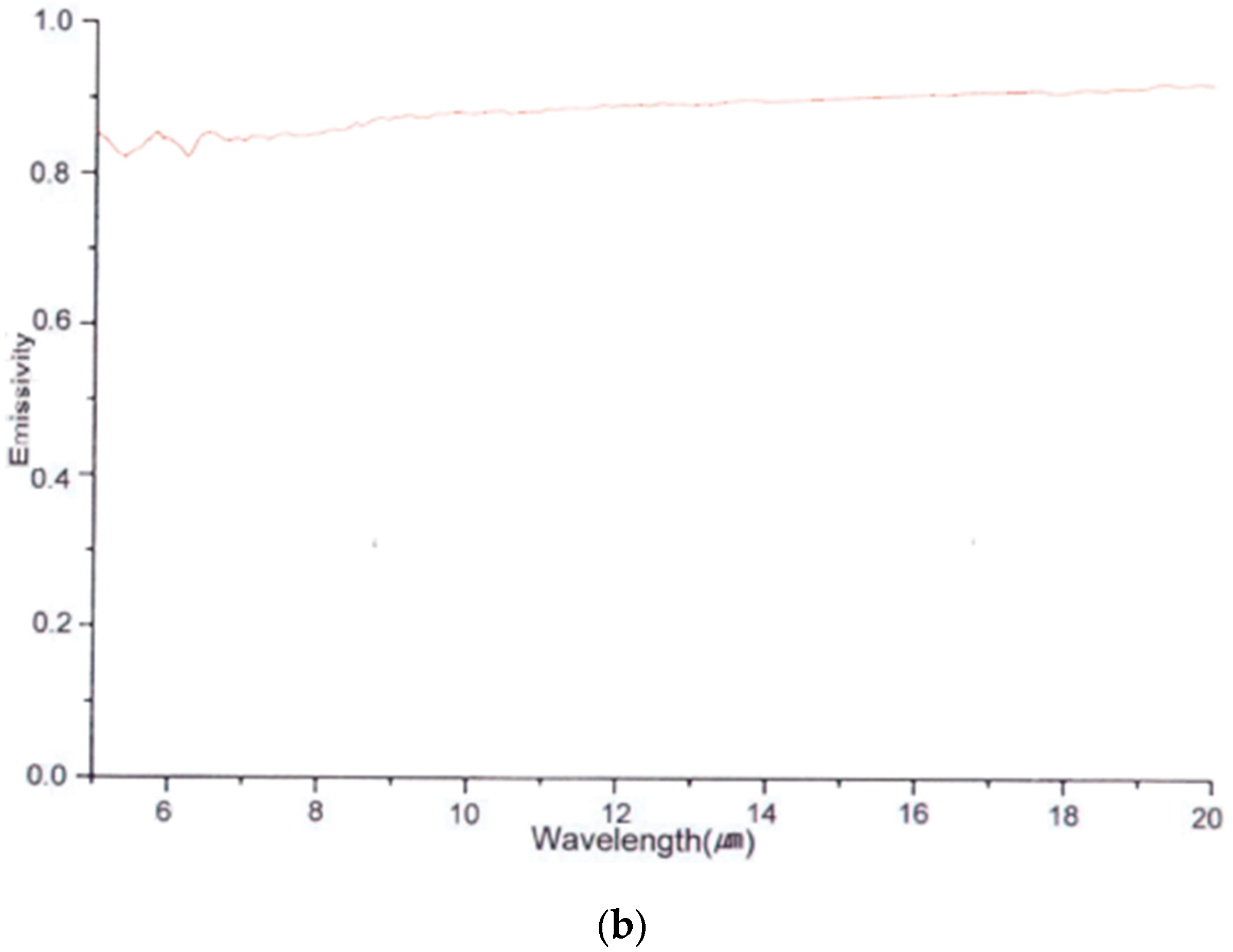

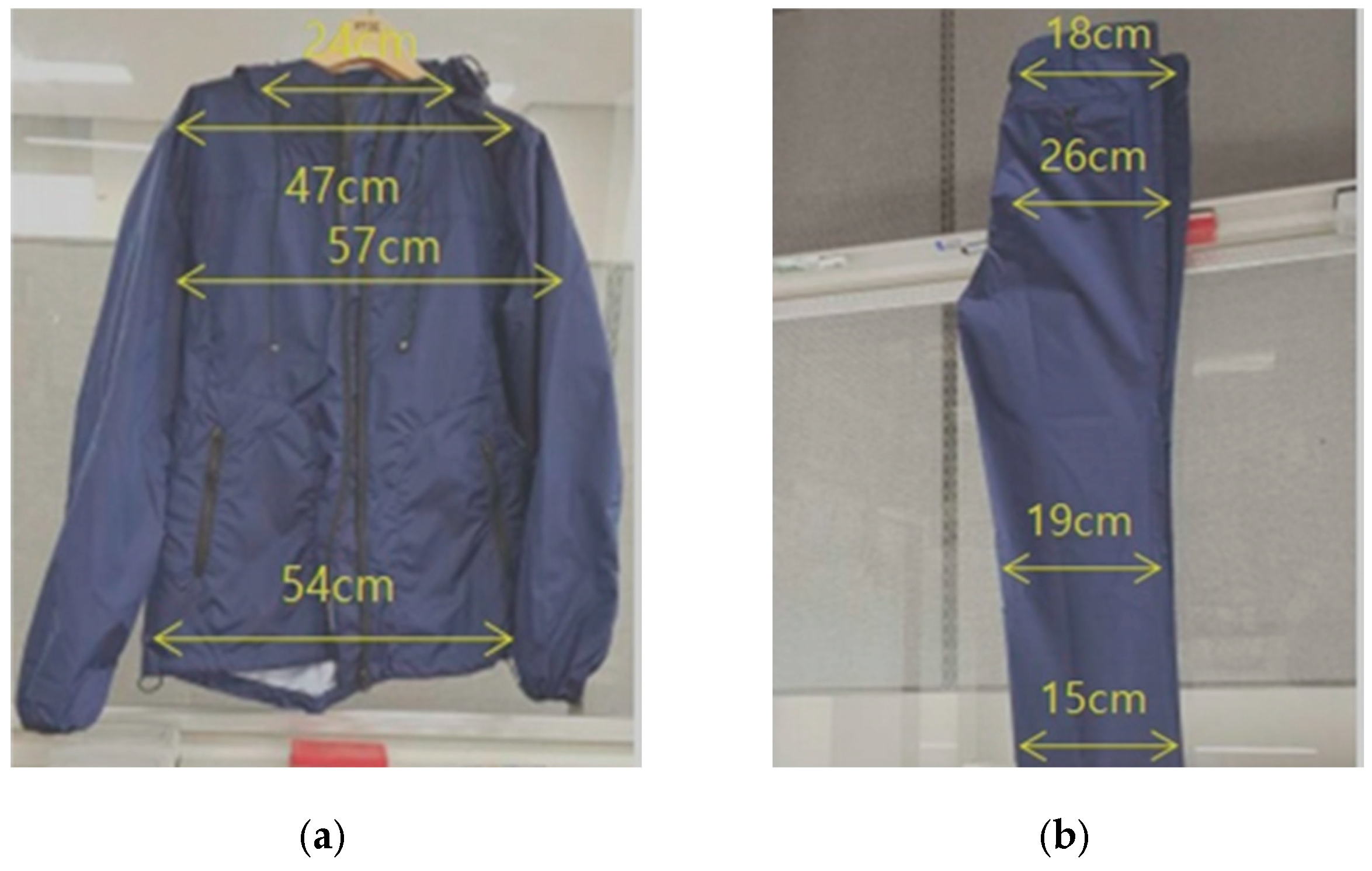
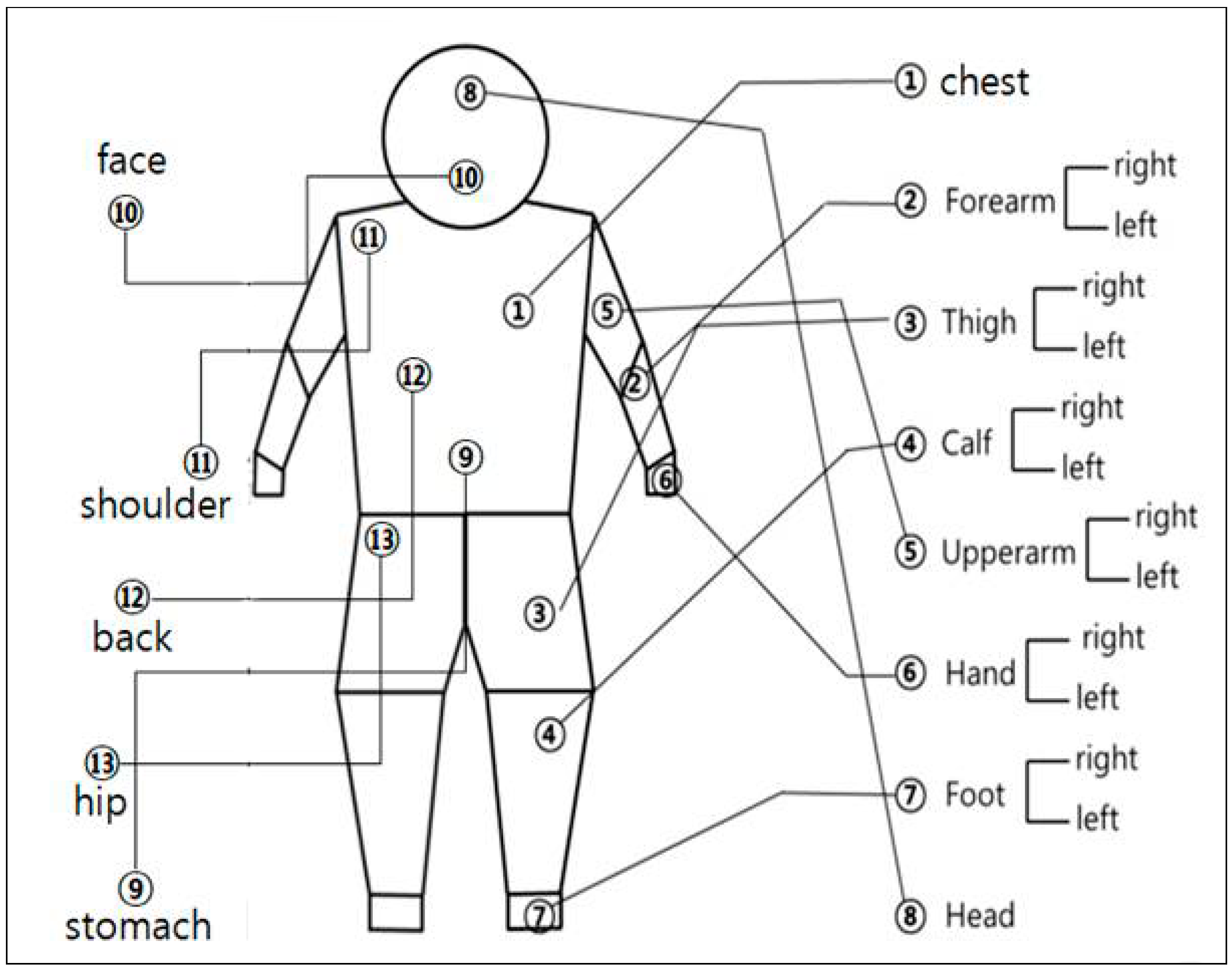
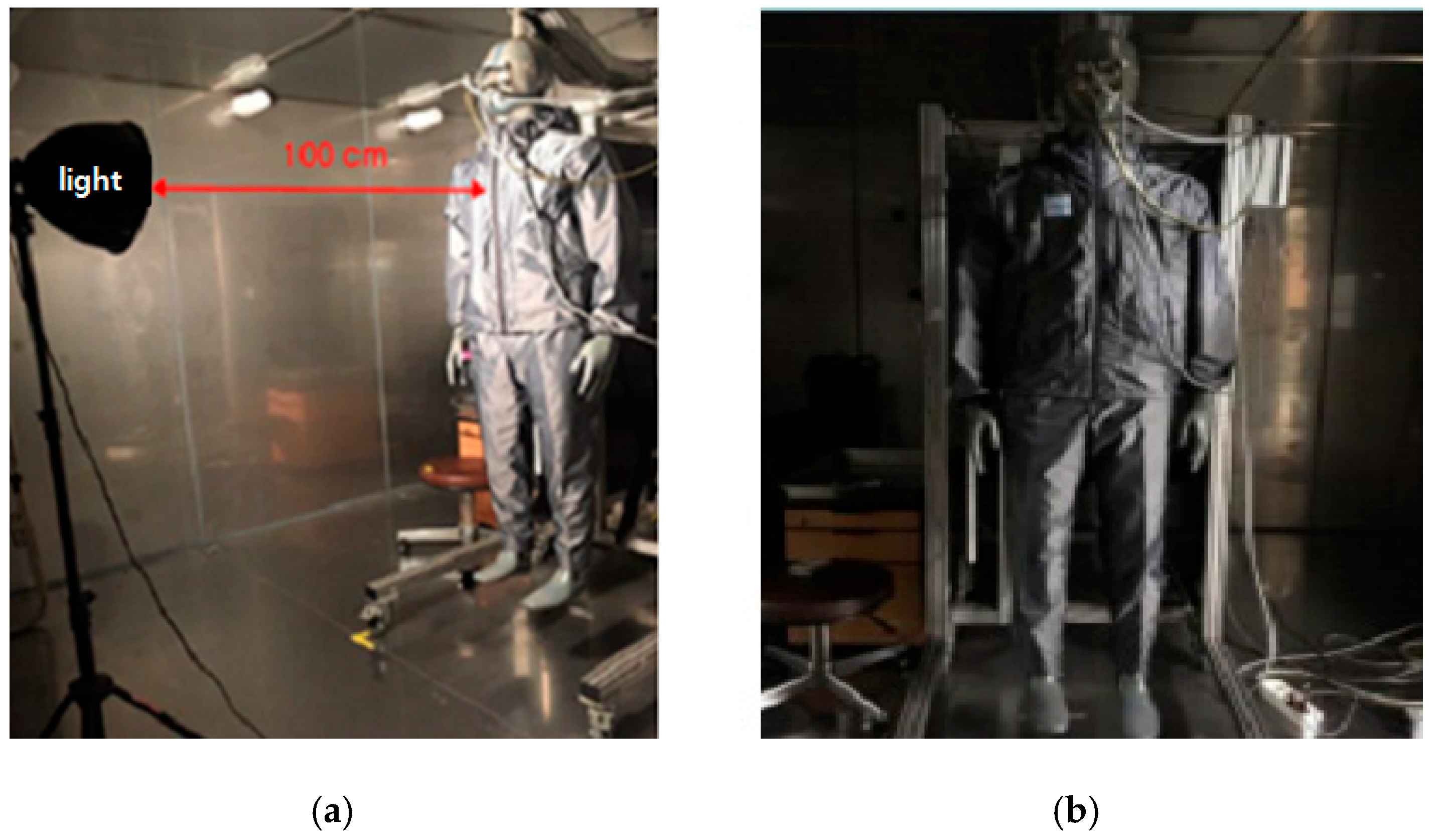
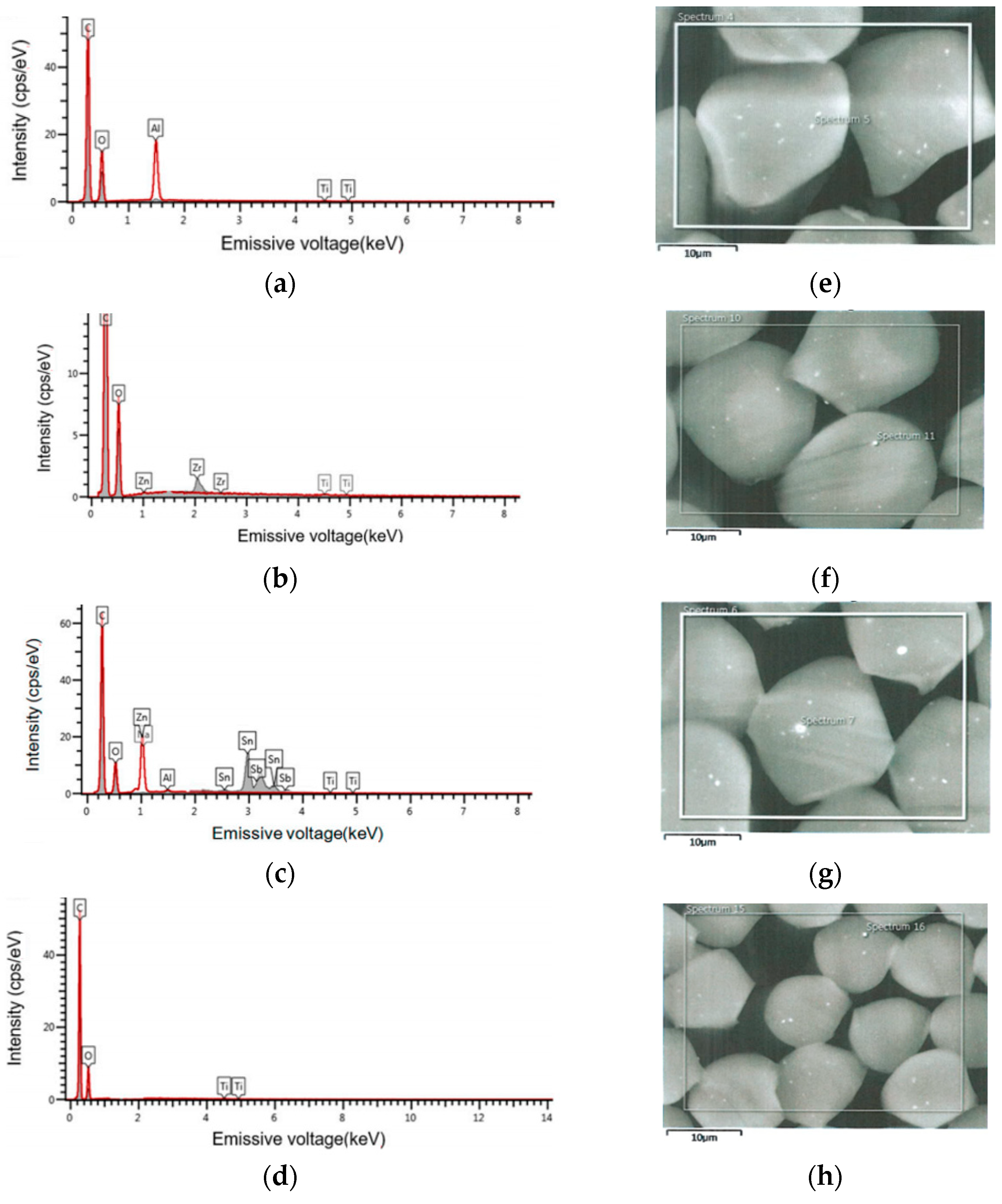


| Ceramic Embedded PET Yarn Specimen | PET Chip Mass | M/B Chip Mass | Mixed Polymer Mass | Mixing Ratio (wt. %) | |||||||
|---|---|---|---|---|---|---|---|---|---|---|---|
| (kilogram) | (kilogram) | (kilogram) | Al2O3 | Graphite | ZnO | ATO | ZrC | Total | |||
| 1 | Al2O3/ Graphite | 45.5 | Al2O3 | Graphite | 50 | 0.7 | 0.1 | 0.8 | |||
| 3.5 | 1.0 | ||||||||||
| 2 | ZnO/ZrC | 48.0 | ZnO | ZrC | 50 | 0.5 | 0.3 | 0.8 | |||
| 1.25 | 0.75 | ||||||||||
| 3 | ZnO/ATO | 48.0 | ZnO | ATO | 50 | 0.5 | 0.3 | 0.8 | |||
| 1.25 | 0.75 | ||||||||||
| Specimen | Yarn Type | Fabric Sett (Picks, Ends/cm) | Thickness(mm) | Mass (g/m2) | Weave Pattern | ||
|---|---|---|---|---|---|---|---|
| Wp | Wf | Wp | Wf | ||||
| 1 | nylon | Al2O3–graphite PET | 51.6 | 35.4 | 0.128 | 84.2 | Plain |
| 2 | nylon | ZnO–ZrC PET | 51.6 | 35.4 | 0.130 | 84.6 | Plain |
| 3 | nylon | ZnO–ATO PET | 51.6 | 35.4 | 0.131 | 84.8 | Plain |
| 4 | nylon | Reg PET | 51.6 | 35.4 | 0.122 | 83.1 | Plain |
| Speci Men | No. | Total Rt | Clo Value | Sub-Thermal Resistance, Rti | |||||||||||||||||||||||
|---|---|---|---|---|---|---|---|---|---|---|---|---|---|---|---|---|---|---|---|---|---|---|---|---|---|---|---|
| (m2·°C/W) | Face | Head | Upperarm | Forearm | Hand | Chest | Shoulders | Stomach | Back | UpThigh | LowThigh | Calf | Foot | AmBient | HumiDity | Setting | |||||||||||
| R | L | R | L | R | L | R | L | R | L | R | L | R | L | R | L | Temp. (°C) | (%) | Temp. (°C) | |||||||||
| 1 | Al2O3 /graphite PET fabric | On | 0.308 | 1.987 | 0.113 | 0.12 | 0.275 | 0.251 | 0.241 | 0.249 | 0.094 | 0.09 | 0.432 | 0.305 | 0.738 | 0.272 | 0.466 | 0.48 | 0.214 | 0.228 | 0.145 | 0.138 | 0.191 | 0.089 | 20 | 48 | 35 |
| Off | 0.243 | 1.567 | 0.084 | 0.115 | 0.228 | 0.217 | 0.198 | 0.211 | 0.088 | 0.083 | 0.234 | 0.301 | 0.395 | 0.264 | 0.403 | 0.416 | 0.194 | 0.209 | 0.136 | 0.13 | 0.085 | 0.085 | |||||
| 2 | ZnO/ZrC PET fabric | On | 0.306 | 1.974 | 0.115 | 0.12 | 0.281 | 0.227 | 0.228 | 0.253 | 0.094 | 0.093 | 0.457 | 0.304 | 0.741 | 0.272 | 0.458 | 0.48 | 0.223 | 0.211 | 0.144 | 0.145 | 0.091 | 0.09 | |||
| Off | 0.237 | 1.529 | 0.084 | 0.115 | 0.229 | 0.204 | 0.19 | 0.212 | 0.088 | 0.085 | 0.235 | 0.3 | 0.376 | 0.265 | 0.386 | 0.389 | 0.2 | 0.193 | 0.134 | 0.138 | 0.084 | 0.083 | |||||
| 3 | ZnO/ATO PET fabric | On | 0.287 | 1.851 | 0.115 | 0.127 | 0.243 | 0.231 | 0.251 | 0.254 | 0.099 | 0.089 | 0.418 | 0.306 | 0.558 | 0.267 | 0.429 | 0.478 | 0.212 | 0.226 | 0.147 | 0.135 | 0.089 | 0.09 | |||
| Off | 0.232 | 1.496 | 0.085 | 0.119 | 0.206 | 0.204 | 0.201 | 0.215 | 0.092 | 0.084 | 0.23 | 0.301 | 0.33 | 0.259 | 0.369 | 0.407 | 0.191 | 0.207 | 0.14 | 0.126 | 0.085 | 0.083 | |||||
| 4 | Regular PET fabric | On | 0.245 | 1.583 | 0.085 | 0.113 | 0.201 | 0.209 | 0.201 | 0.209 | 0.092 | 0.082 | 0.245 | 0.281 | 0.354 | 0.272 | 0.31 | 0.354 | 0.191 | 0.204 | 0.127 | 0.131 | 0.082 | 0.081 | |||
| Off | 0.214 | 1.382 | 0.078 | 0.009 | 0.198 | 0.19 | 0.178 | 0.201 | 0.081 | 0.078 | 0.21 | 0.273 | 0.321 | 0.251 | 0.371 | 0.368 | 0.181 | 0.183 | 0.121 | 0.114 | 0.072 | 0.074 | |||||
| Experimental Condition | Fabric Specimens | Total Clo | Stomach Clo | Chest Clo | |||
|---|---|---|---|---|---|---|---|
| Mean | Dev. | Mean | Dev. | Mean | Dev. | ||
| Light On | 1. Al2O3/graphite PET fabric | 1.987 | 0.257 | 4.760 | 0.610 | 2.786 | 0.212 |
| 2. ZnO/ZrC PET fabric | 1.974 | 0.214 | 4.779 | 0.800 | 2.948 | 0.250 | |
| 3. ZnO/ATO PET fabric | 1.851 | 0.257 | 3.599 | 0.650 | 2.696 | 0.238 | |
| 4. Regular PET fabric | 1.583 | 0.199 | 2.283 | 0.500 | 1.580 | 0.187 | |
| Light Off | 1. Al2O3/graphite PET fabric | 1.567 | 0.209 | 2.548 | 0.216 | 1.509 | 0.216 |
| 2. ZnO/ZrC PET fabric | 1.529 | 0.210 | 2.425 | 0.291 | 1.516 | 0.262 | |
| 3. ZnO/ATO PET fabric | 1.496 | 0.234 | 2.129 | 0.293 | 1.484 | 0.223 | |
| 4. Regular PET fabric | 1.382 | 0.227 | 2.070 | 0.347 | 1.355 | 0.256 | |
| Each Clo | F-Value (F0) | F (3, 16, 0.95) | p-Value | |
|---|---|---|---|---|
| Light-on | Total Clo | 15.91 | 3.24 | 4.64 × 10−5 |
| Stomach Clo | 106.13 | 3.24 | 8.98 × 10−11 | |
| Chest Clo | 372.43 | 3.24 | 5.24 × 10−15 | |
| Light-off | Total Clo | 10.47 | 3.24 | 4.70 × 10−40 |
| Stomach Clo | 21.51 | 3.24 | 7.36 × 10−6 | |
| Chest Clo | 3.35 | 3.24 | 0.045 |
| Specimens Physical Properties | 1 | 2 | 3 | 4 | ||||||||
|---|---|---|---|---|---|---|---|---|---|---|---|---|
| Al2O3/Graphite | ZnO/ZrC | ZnO/ATO | Regular | |||||||||
| M | D | M | D | M | D | M | D | |||||
| Heat retention rate (I, %) | 40.7 | +0.9 | −0.7 | 40.3 | +1.3 | −0.9 | 39.4 | +1.4 | −0.8 | 35.4 | +1.1 | −0.8 |
| F-test result | F-value (F0) | F (3, 16, 0.95) | p-value | |||||||||
| 44.77 | 3.239 | 5.24 × 10−0.8 | ||||||||||
Disclaimer/Publisher’s Note: The statements, opinions and data contained in all publications are solely those of the individual author(s) and contributor(s) and not of MDPI and/or the editor(s). MDPI and/or the editor(s) disclaim responsibility for any injury to people or property resulting from any ideas, methods, instructions or products referred to in the content. |
© 2023 by the author. Licensee MDPI, Basel, Switzerland. This article is an open access article distributed under the terms and conditions of the Creative Commons Attribution (CC BY) license (https://creativecommons.org/licenses/by/4.0/).
Share and Cite
Kim, H.-A. Manufacturing and Properties of Various Ceramic-Embedded Composite Fabrics for Protective Clothing in Gas and Oil Industries Part II: Thermal Wear Comfort via Thermal Manikin. Coatings 2023, 13, 1778. https://doi.org/10.3390/coatings13101778
Kim H-A. Manufacturing and Properties of Various Ceramic-Embedded Composite Fabrics for Protective Clothing in Gas and Oil Industries Part II: Thermal Wear Comfort via Thermal Manikin. Coatings. 2023; 13(10):1778. https://doi.org/10.3390/coatings13101778
Chicago/Turabian StyleKim, Hyun-Ah. 2023. "Manufacturing and Properties of Various Ceramic-Embedded Composite Fabrics for Protective Clothing in Gas and Oil Industries Part II: Thermal Wear Comfort via Thermal Manikin" Coatings 13, no. 10: 1778. https://doi.org/10.3390/coatings13101778
APA StyleKim, H.-A. (2023). Manufacturing and Properties of Various Ceramic-Embedded Composite Fabrics for Protective Clothing in Gas and Oil Industries Part II: Thermal Wear Comfort via Thermal Manikin. Coatings, 13(10), 1778. https://doi.org/10.3390/coatings13101778





